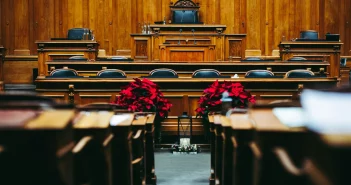Introduction
However scant the support provided by the legal process, as a lawyer I am drawn to rights-driven considerations. In terms of recent context – blinkered by the present over-reaction – Obama’s climate change initiative has been overturned by Trump, who effectively tore up the Kyoto Accord.
The internal U.S. solution to climate issues is to endorse such market-driven approaches as ‘Cap and Trade’. For example the Law and Economics movement allows and encourages individual U.S. States to permit, through legislation, permission to purchase the right to pollute. Obviously what happens is that once a corporation’s pollution credit is exhausted in a given State they simply move on. It is, in short, a polluter’s charter.
A pollution or carbon tax is justified on the basis that it will promote efficiency but little account is taken of the externalisation of environmental meltdown, or on whether it is regressive or not. China’s ongoing disregard for pollution controls and restraints on consumption is well documented. The excuse given is that the U.S. is doing worse. So there seems to be little hope of the Big Two changing course.
Nonetheless, as we will see, such ‘environmental rights’ as there are can be divided into three distinct categories: environmental procedural rights; the right of environment and the right to environment.
A Consensus of Crisis
Discourse on the status of the Blue Planet is varied and complex. On the one hand it is quite clear that it will survive climate chaos even if humankind does not. Gaia, as James Lovelock conceives her, has an infinite capacity for renewal and regeneration. But the scale and imminence of the impending disaster is being carefully manipulated in the vectors of public opinion. Trump, Bannon and others should be indicted for the crime against humanity of ecocide.
The science is saying – the work of Elizabeth Colbert in particular – that without radical action, within sixty years the remaining wild mammals may be extinct. In these circumstances human extinction is likely to occur by increments.
Various parts of Earth will be rendered uninhabitable through plant and animal die outs, destroying natural habitats and accelerating ecological meltdown. Raised temperatures will foster further mass migrations, with no clear destination, or pity, emanating from the privileged few, as quarantining of refugees in secluded detention centres becomes the norm.
Radical inequalities in wealth and assets will diminish life expectancies through poverty and an under-resourced and undermined welfare system. Death on the Instalment Plan, as Louis-Ferdinand Céline put it after the Great Depression awaits for many of us. So in the medium term a mass extinction seems unlikely. More likely there will be significant population culls as a cost-benefit analysis to human life is applied.
A crucial consideration, flagged in detail by John Gray, is that the top soil on which agriculture rests is being rapidly eroded. Furthermore, of even greater concern perhaps, is that chemical inputs into agriculture are wreaking havoc with natural ecosystems.
Gray has previously argued in favour of an alliance between moderate conservatism and the green agenda, conserving venerable institutions while enhancing environmental and civic health. This is a variant on sustainable growth or development. Unfortunately, this admirable ideal appears to have little chance of success in the real world of power and money.
Besides, the post-truth plague has put wind in the sails of climate change denial, as inaccurate and self-serving ideas are peddled by the likes of Michael O’Leary. These are accepted as valid points of view, as part of a misplaced notion of balanced coverage.
The agenda is clear. The far-right prizes its assets and its riches, and prefers to pillage the Earth, rather than protect the planet.
Collapsing Glaciers, Arundhati Roy and Indian Precedent
According to the Geophysical Research Letters the ongoing melting of the glaciers of Antarctica is expected to be exacerbated by the collapse of the greatest canyon on earth: the Denman Glacier. By now the glacier is mostly cut off from the sea due to the level of glacial ice piled inside and atop the ravine.
As the glacier’s edge continues to retreat down the slope, however, warm ocean currents will pour into the canyon, battering bigger and bigger sections of the glacier and gradually turning the Denman trough into a giant bowl of melt water, with nowhere to go. This scenario could have a runaway feedback loop of melt that ultimately returns all of Denman Glacier’s ice to the sea — risking a nearly 5 feet (1.5 m) rise in the planet’s sea level.
Antarctica’s Massive Denman Glacier Retreats 3 Miles in 22 Years | The Weather Channel https://t.co/OfyZfbWTez Yep, other important stuff is still happening… pic.twitter.com/oRKmCd3Eec
— Dr. David L. Katz (@DrDavidKatz) March 25, 2020
This could lead to significant migrations from South to North – a mass exodus in fact – as overheating increases, joining the ever prevalent boats arriving in Sicily and elsewhere on the Mediterranean. I fear increasingly draconian measures to control migration and effectively dispose of fellow human beings.
The developed world is not immune however. The environmental crisis, coupled with inevitable pandemics to come, is likely to precipitates a global financial collapse. The recent Financial Crisis has already brought ‘strong man’ leaders, and an increasingly oppressive jackboot state in so-called democracies.
Assets need to be preserved, and those who threaten the status quo and the inward rapacious march of unchecked capitalism may be disposed of. As John Gray remarked in a different context: ‘The quickening advance of science and technology in the past few centuries has not gone with any comparable advance in civilization or human rationality.’
Many human rights organizations reliant on funding and sponsorship from right-wing think tanks are becoming less than eager to confront the hard issues, as the consequences for doing so is a withdrawal of funding. The priorities of the Ford Foundation and others, who fund NGOs, brings a devotion to identity politics rather than the crucial issue of climate change.
Those therefore, such as the Indian writer Arundhati Roy, who challenge rapacious capitalism around the world, or have the temerity to object to its nefarious agenda will be murdered, imprisoned or simply disappeared. This goes hand-in-hand with sectarian repression in India where, ‘people are graded and assessed according to their faith.’
Naomi Klein has offered a powerful critique in a series of books ever since The Shock Doctrine (2007). The important point to grasp is that the Chicago School approach of enforced shocks and distractions occlude sinister power grabs. The Covid-19 pandemic is a perfect sideshow in this respect for a shake down by large corporations. Over-reaction and mass hysteria about a virus becomes another distraction from a bigger picture of environmental, and social, meltdown.
In India and beyond, Arundhati Roy demonstrates how neo-liberalism and environmental damage go hand in glove in her Capitalism a Ghost Story (2014). Since the publication of The God of Small Things (1997) she has channelled her energies into political activism against the growing environmental and economic calamity being perpetrated on her native land, through the depredations of neo-liberalism. It is that political conscience that is the primary interest of her new awareness.
In Capitalism: a Ghost Story there are all sorts of resonances to her new work of politicized fiction The Ministry of Utmost Unhappiness. There is the mass evictions of India’s ‘surplus population.’ The street vendors, rickshaw riders, the small shops and business people, that brought the suicide of 250,000 farmers. This forced displacement, often from rural areas to cities, augments wealth of the one percent of plutocrats who control India. A graveyard, or simply being simply dumped in a river bed, is often the fate of the displaced, or the disappeared.
It is clear in both books that this is the product of a society where corruption is endemic. Inequality works to the benefit of monopolistic corporate interests, involving crossover interests of transnational corporations and law firms. Even the NGO sector won’t cut it as Roy saliently points out: ‘charity douses anger with pity.’ It can even silence criticism of neo-liberal atrocities by deflecting attention to ‘safer’ human rights issues such as gender equity.
Roy has suggested that Covid-19 offers a portal that may allow us to mend the error of our ways. I hope she is right.
Dissent from Sweden
This brings us to Greta Thunberg, our only child public intellectual. Aged just sixteen, Time Magazine saw fit to make her its person of the year for 2019. She became famous for not attending school to demonstrate against her government’s inaction over climate change, leading to a spate of copycat demonstrations.
Her recent short text, available in any decent book store for £2.99, No One is Too Small to Make a Difference (2019), provides a summary of her speeches. She questions, given an imminent mass extinction, whether attending school is a terribly worthwhile idea, and identifies a cathedral solution. This is a brilliant analogy as we need deep structural and integrative thinking, and the leadership of the just and the wise. She might also have noted that serfs and slaves built the cathedrals, just as wage-slaves constructed those great cathedrals of capitalism: the skyscrapers.
On Monday my book “No One Is Too Small To Make A Difference” will be released in the United States. This is an updated edition with more speeches, which will be released in other countries and languages soon as well. And all my earnings will go to charity. pic.twitter.com/QH6X9edHnS
— Greta Thunberg (@GretaThunberg) November 9, 2019
Greta Thunberg sees the world through black and white lenses. Good and evil. This provides a refreshing clarity, demanding action to be taken now, or her generation has no future. She is right insofar as the overwhelming majority of scientists are to be believed.
Fortunately she is Swedish and retains a comparative freedom to speak her mind, despite the chastisements of Mr. Trump. The writ of neo-liberal justice does not extend to that Nordic country just yet.
Little wonder also that anarcho-syndicalist groups such as Extinction Rebellion have gained traction when the political process has failed. The dangerous vista of extra-legal tactics, beyond civil disobedience, is on the horizon. The beast is slouching towards Bethlehem.
Applying Sustainability in Our Daily Lives.
There are also environmental considerations about the quality of civic life. Alain de Botton’s The Architecture of Happiness (2006) argues that the kind of buildings we inhabit and work in make a profound effect on our wellbeing. The poet Kathleen Raine pointed to a sense of homecoming when we encounter cities ‘where in architecture, sculpture and painting, the needs of the spirit are met.’ She attributes a growing alienation in the Britain of the 1960s to the architectural fashion of the time.
It is self-evident that operating in an aesthetically pleasing home environment will raise the spirits, and yet this idea is often dismissed. Placing people in Bauhaus tower blocks creates battery hens. America is the paradigm of the skyscraper mentality, with Chicago’s Louis Sullivan ‘the father of the skyscraper.’
I have visited perhaps the seminal modernist or rather brutalist example of sustainable living apartments. Le Corbusier’s Unite d’Habitation (1952) is the perfect expression of his idea of ‘a machine for living in.’ Although wonderful in principle, in application it is a bastardised disaster.

East elevation of Unité d’habitation Marseille in 2019
How can you function properly, or think straight, while raising a young family living in an overpriced tenement which chews up most of your salary? Commuting to work compounds the problem, as you spend your spare hours on a train going to and from an ‘open plan’ panopticon of a workplace that generally diminishes your wellbeing. Sedentarism and a lack of exercise will shorten your life span and diminish a capacity to think freely. Failures in Irish urban planning, such as Ballymun Tower Blocks, lay behind the heroin epidemic of the 1980s.
Yet there is good urban planning that raises the spirit. Paris was a crime and slum invested medieval city until the Baron de Haussmann developed a prototypical grid system, after Napoleon III instructed him to bring air and light to cetnre the city, to unify the different neighbourhoods with boulevards, and to make the city more beautiful. Yet today beyond the city limits, the architectural depredation of les banlieues has engendered the social dislocation and La Haine.

Camille Pissaro, Avenue de l’Opera
In Ireland Mary Robinson spearheaded an attempt to preserve the Viking Wood Quay settlement many decades ago, which was an early intimation of her ongoing attempts to raise global conscience, and force environmental regulation and climate change awareness in Ireland.
It should be noted that great businessmen – which is not entirely an oxymoronic idea – think long-term and in terms of fundamentals of life. Benevolent capitalists, such as the Adriano Olivetti and John Cadbury, had regard to the quality of life of workers and housed them appropriately, endowing long obsolete privileges such as pensions and benefits.
We need to discover an ecologically harmonious way of living rather than simply eco-friendly consumer choices, such as one discovers in a fabulous recent book called, Norwegian Wood: Chopping, Stacking and Drying Wood the Scandinavian Way.
Imperfect Legal Solutions
As indicated, in procedural legal terms the broad notion of ‘environmental rights’ can be divided into three distinct categories: environmental procedural rights; the right of environment and the right to environment.
Environmental procedural rights include those associated with rights of participation in decision-making, access to information and the ability to access justice, such as is expressed in the Aarhus Convention under European Union Law. But any consultative processes and public hearings are irrelevant if outcomes are pre-determined.
The right of environment is perhaps the most radical, envisaging as it does a value in the environment beyond mere human benefit. Such an approach assumes that the environment should be held as a good on its own merits, and protected as such. The argument is based on the position that it is arbitrary to restrict justice and rights exclusively to inter-human relationships and to tolerate a situation in which interested parties are deprived of essential values in the distributive process on the basis of morally irrelevant factors – such as their not being human.
Ireland: Could ‘Wild Law’ save species from #extinction? The Path of Natural Justice. Large corporations have already positioned themselves to profit from the commercial windfalls presented by #ClimateChange #CSR #WildLaw https://t.co/vm10SSequ1 pic.twitter.com/iDJQRh2WsS
— pdjmoo (@pdjmoo) March 1, 2019
Finally, there is the right to environment. This was first given international expression in the Stockholm Declaration, Principle 1 of which stated that ‘[m]an has the fundamental right to freedom, equality and adequate conditions of life, in an environment of a quality that permits a life of dignity and well-being …’
The right to environment is conceptualized as a right pertaining to each individual – the environment is valued not on its own merits, but in light of its importance for human existence. The exact description of the right has been framed in various ways. A range of adjectives have been used: decent, healthful, natural, pure, clean, ecologically-balanced, safe (see International Environmental Law and Policy for the 21st Century, Pring and Nanda). Throughout the literature, a common theme is that of ensuring human health is not put at risk by environmental degradation. Obviously, this approach is open to the criticism that it is entirely anthropocentric.
So do we assess the environment as a benefit to us as humans or as an intrinsic good in and of itself? I would argue in favour of the latter approach. But legal case law and rights are toothless fairies if there is no political will to implement them.
Coda
So legislative and constitutional protections exist and lobbying continues apace. This seems destined to fail, although I have not given up hope. In the present circumstances – portals or otherwise – as creatures of bounded rationality, with limited time, what we can do in our own lives is at least try and do as little harm as possible.




